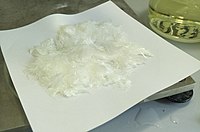
Photo from wikipedia
Lead (Pb) is a typical hazardous element of high concern in species characteristics involving toxicity, migration and transformation. A greenhouse experiment was conducted using Solanum nigrum L. grown in soils… Click to show full abstract
Lead (Pb) is a typical hazardous element of high concern in species characteristics involving toxicity, migration and transformation. A greenhouse experiment was conducted using Solanum nigrum L. grown in soils treated by divalent (Pb2+), tetravalent (Pb4+), trimethyl (TML) and triethyl (TEL) lead for 60 days. Results of physio-biochemical parameters indicated Pb toxicity was ranked as TEL > TML > Pb2+ > Pb4+ in a dose-dependent manner, and the correlation levels of organic species were higher than inorganic species. S. nigrum L. adopted phytostabilization strategy through fixing Pb in roots and restricting its transfer to shoots. More phytotoxic Pb was absorbed from soils treated by Pb2+ than Pb4+ as well as TEL than TML. In soils, inorganic Pb species were mainly present in residues while organic Pb species in Fe/Mn oxide and exchangeable fractions. Although most of Pb species in plant existed in the low-bioavailable extractions of 1 M NaCl and 2% HAC, the water-soluble Pb extracted by d-H2O and 80 % ethanol were increased to a large extent under high-level exposure. The occurrence of reduction and (de)alkylation were considered as the major pathways in the biotransformation of Pb species. This study will conduce to the ecological risk management for Pb-contaminated soils.
Journal Title: Journal of hazardous materials
Year Published: 2020
Link to full text (if available)
Share on Social Media: Sign Up to like & get
recommendations!